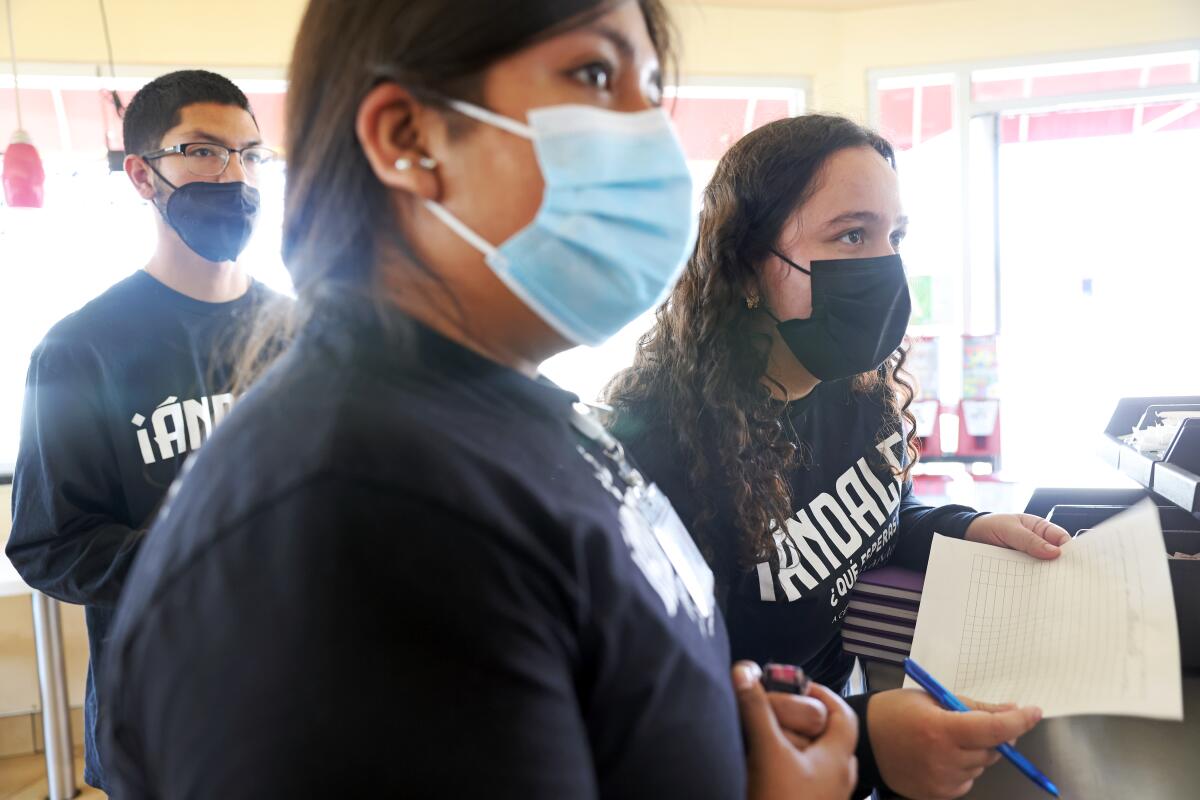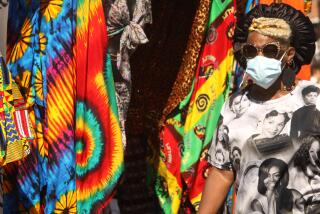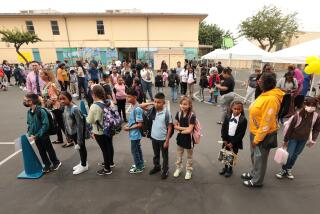How will L.A. County find warning signs of the next coronavirus surge?

- Share via
As the Omicron surge of the coronavirus continues to wane, Los Angeles County has been lifting COVID-19 mandates, including indoor masking and vaccine verification in certain settings.
But with those guardrails removed, how will health officials detect signs of potential surges?
The obvious tools of tracking new coronavirus cases and COVID-19 hospitalizations are still in place. But there are seven other indicators that L.A. County plans to monitor as part of an early warning system, according to Public Health Director Barbara Ferrer.
“These can alert us early to concerning trends that might lead to higher COVID-19 transmission or increased illness severity,” she said.
The county still needs to be prepared for worst-case scenarios that could warrant a return to universal masking — such as if COVID-19 vaccines fail to provide robust protection against a new variant of concern, leaving people at higher risk for severe illness.
“Then, we’ve got to look at everything else that’s in the toolbox, which is going to be the distancing and the masking,” she said.
But while preparedness is always important, based on current trends, Ferrer doesn’t anticipate returning to universal masking indoors anytime soon.
“I don’t actually see that sort of in the near horizon at all,” she said.
7 warning signs
According to the latest available data, L.A. County’s report card remains in solid shape across all seven of the tracked metrics.
Variants: The percentage of collected coronavirus specimens that are a new variant of concern. The goal is to have fewer than 5%; there are currently no new variants of concern, as defined by the World Health Organization.
Emergency rooms: The percentage of coronavirus-related emergency room visits over a weekly period. The goal is to have fewer than 5%; the latest figure is 4.3%.
Low-income areas: The case rate for L.A. County’s lowest income areas. The goal is to have fewer than 100 cases a week for every 100,000 residents in poor areas; the most recent rate is 51.
L.A. County also will monitor the number of outbreaks in four specific settings of concern:
Nursing homes: The goal is to keep the number of weekly outbreaks at skilled nursing facilities at fewer than 11 a week; there were four in the most recent week.
K-12 school settings: The aim is to keep the number of outbreaks at fewer than four a week; there were four in the most recent week.
Homeless shelters: Officials are seeking to keep the number of outbreaks in settings involving people experiencing homelessness to fewer than 11 a week; there were eight in the most recent week.
Worksites: Authorities want to keep the number of outbreaks at worksites to fewer than 100 a week; there were 30 in the most recent week.
Where do we stand now?
The only rubric that caused health officials moderate concern was the number of new outbreaks in K-12 settings. But that number, too, has been declining. There were four in the most recent week and seven the week before. Between four and nine outbreaks a week represents a moderate level of concern, and 10 or higher a high level of concern, according to the county.
However, just because the relative risks are lower now than earlier in the year doesn’t mean caution isn’t still warranted. L.A. County continues to strongly recommend masking indoors for staff and students, even after state requirements lifted Friday night. L.A. County also is recommending weekly testing of unvaccinated people at school sites.
If there are alerts in two or more areas that reach a moderate or high level of concern, “we’ll conduct an in-depth review of contributing factors and consider changes to community-prevention strategies,” Ferrer said.
In the meantime, Angelenos have been able to enjoy mask-free outings in indoor public settings for a week.
Ferrer said in a recent interview the county’s decision to lift the mask mandate was not based on political pressure, though she acknowledged there had been a loud group of people pushing for its end.
Instead, she said the decision was made in light of new guidelines established by the U.S. Centers for Disease Control and Prevention, which found on March 3 that L.A. County no longer was an area where universal mask wearing indoors was recommended.
Ferrer is still strongly recommending universal mask wearing in indoor public settings regardless of vaccination status, a recommendation echoed by California state health officials.
“I obviously want everybody to keep a mask on,” Ferrer said in the interview. “I’m very clear about what I think is the safest way to get through the next few weeks, and that is to go ahead and keep a mask on.”
While there’s been much attention paid to critics of the mask order, Ferrer noted that “a lot of people are still wearing their masks.” Those who are still wearing them are often quieter, she said, and anticipates they will “continue to wear their masks for some time to come and feel very comfortable wearing their masks.”
While L.A. County’s coronavirus community level is low — essentially meaning the hospital system is not under severe strain — transmission rates are still considered substantial, at 73 cases a week for every 100,000 residents, according to The Times’ coronavirus tracker as of Sunday. That “means there’s just a fair amount of virus still circulating,” Ferrer said at a briefing Thursday.
To get to a moderate coronavirus transmission level, the rate will need to dip below 50 cases a week for every 100,000 residents; for low transmission level it needs to be below 10.
“Once those numbers drop, I think everybody will feel a lot more comfortable” easing the strong recommendation to wear masks, Ferrer said, and instead perhaps suggesting only those at higher risk of COVID — or those living with people at higher risk — keep their masks on in indoor public settings.
Ferrer said Thursday she will be looking closely to see whether case rates rise after the mandatory masking order at schools and child-care sites lifts.
“Within a few weeks, we’ll see whether or not we have more transmission at schools,” Ferrer said. “If we start seeing some significant increases in outbreaks — which is transmission that happens at school — we’ll have to go back and revisit this guidance. Because the last thing anybody wants is more transmission in schools.”
A 5-step preparedness plan
L.A. County also has prepared a five-step plan to respond quickly should signs of a new uptick in infection emerge.
Outbreaks: Workplaces are required to report three or more coronavirus cases detected within a 14-day period, and officials will recommend measures the employers take to keep outbreaks under control.
Testing: Ensure access to free and accessible testing, especially in areas with high case rates.
Therapeutics: Ensure a vast network of providers with anti-COVID drugs. Distribution of some of these drugs remains uneven countywide, and is low in places like South L.A., East L.A., parts of the San Fernando, San Gabriel, Santa Clarita and Antelope valleys, and Malibu. Some wealthier areas are seeing higher levels of drug distribution, including the Hollywood Hills and the Palos Verdes Peninsula.
Vaccinations: Maintain a network of 300 mobile vaccine teams and 1,000 fixed vaccination sites. Officials also want to increase the number of health plans that provide vaccines to people who can’t leave home for health reasons.
Surveillance: Analyze 15% to 25% of collected coronavirus samples countywide and sequence them to identify variants, and expand wastewater testing to detect coronavirus infection trends.
More to Read
Sign up for Essential California
The most important California stories and recommendations in your inbox every morning.
You may occasionally receive promotional content from the Los Angeles Times.












